Bark key for Dutch hardwood trees
This bark key is part of the winter key for recognizing Dutch hardwood trees. It should not be seen as a key in itself, but as a part of the whole winter-key. The winter key part one is the elimination winter key. The second part is the bud key. Besides all this there is a summer-bark page just for fun.
This bark key is photographical and consists of showing four classes of pics:
1. Characteristic bark Like Birch and so on.
2. Smooth bark
3. Coarse bark
4. Cracked bark or halfway between smooth and coarse
The coarse and cracked bark are on the second winter bark-page, because there are too many photo's for one.
First the bark you also could have identified with the elimination winter key :
1. Characteristic bark
1. Characteristic bark | 2. Smooth bark | 3. Coarse bark | 4. Cracked bark or halfway between smooth and coarse | Back to the bud page
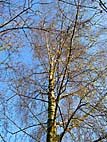 Everyone knows the Birch with its white bark.
Photo's of buds here.
Everyone knows the Birch with its white bark.
Photo's of buds here.
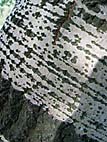 De Poplargenus has three species with a grey bark:
De Poplargenus has three species with a grey bark:
European white poplar Populus alba and
Aspen Populus tremula and
Grey poplar Populus canescens
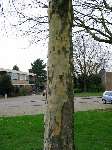



 Species with bark where small pieces fall of are London planetree(Platanus hybrida ) and Oriental planetree. Photo's of buds here.
Species with bark where small pieces fall of are London planetree(Platanus hybrida ) and Oriental planetree. Photo's of buds here.
 Also missing pieces of bark can be (not al individuals have this) Sycamore maple (Acer pseudoplatanus ). Also recognizable by bunches of stalks where the winged fruits were attached and by the beautiful green buds. Photo's of buds here.
Also missing pieces of bark can be (not al individuals have this) Sycamore maple (Acer pseudoplatanus ). Also recognizable by bunches of stalks where the winged fruits were attached and by the beautiful green buds. Photo's of buds here.
 The
Horse chestnut Aesculus hippocastanum also misses pieces of bark when it gets big. Photo's of buds here.
The
Horse chestnut Aesculus hippocastanum also misses pieces of bark when it gets big. Photo's of buds here.
 A very coarse characteristic grey bark has
A very coarse characteristic grey bark has
Black locust Robinia pseudoacacia.
similar is the 
Caucasian Wingnut Pterocarya fraxinifolia . Photo's of buds here.



 De
Sweet cherry Prunus avium, has characteristic shiny horizontal bands of bark. Photo's of buds here.
De
Sweet cherry Prunus avium, has characteristic shiny horizontal bands of bark. Photo's of buds here.
Smooth bark
1. Characteristic bark | 2. Smooth bark | 3. Coarse bark | 4. Cracked bark or halfway between smooth and coarse | Back to the bud page
When a tree has a smooth bark while being at least about 40 to 60 cm around you might find it here. Trees that are listed above are not included.
There are not really many tree species that have smooth bark. These do:
- European Beech Fagus sylvatica (bark stays smooth even when bigger than 2 metres around. Although it gets some scars when it gets bigger. But never really coarse bark with grooves. Photo's of buds here.
- Common ash Fraxinus excelsior (until a meter around often smooth bark. After that it can get some ridges. Easily recognizable by its big black hove-shaped buds. Photo's of buds here.
- Manna Ash, or Flowering Ash Fraxinus ornus (Haven't seen it more than 60 cm around so wouldn't know how it looks bigger than that. Has peculiar white spots on the bark, but I am not sure if that is common. Buds are strikingly symmetric and grey. Photo's of buds here.
- Sycamore maple Acer pseudoplatanus can stay smooth uptil 60 cm around or more. It can also have little pieces of bark missing, which gives it a spotty look. Strikingly green buds and often bunches of stalks on the tree in the winter where the winged-fruit used to be attached. Photo's of buds here.
- European hornbeam; Musclewood; Ironwood Carpinus betulus. Some individuals look as smooth as European beech, others have a more cracked bark. Photo's of buds here.
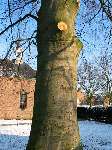
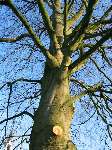
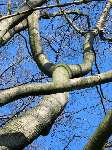
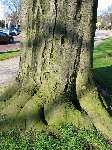
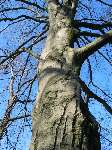
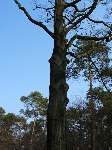
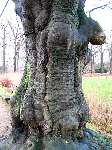


















Coarse bark and cracked bark are at the second winter bark-page.
